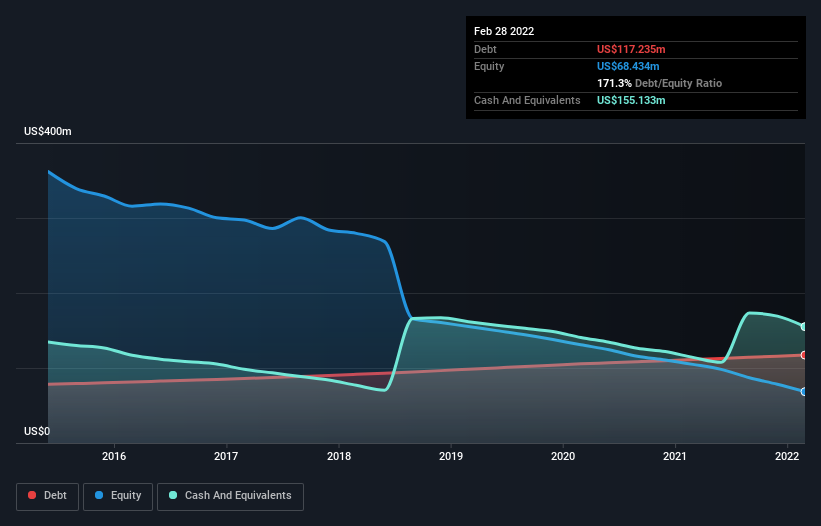Is NovaGold Resources (TSE:NG) Using Debt Sensibly?
Some say volatility, rather than debt, is the best way to think about risk as an investor, but Warren Buffett famously said that 'Volatility is far from synonymous with risk.' So it might be obvious that you need to consider debt, when you think about how risky any given stock is, because too much debt can sink a company. We can see that NovaGold Resources Inc. (TSE:NG) does use debt in its business. But the real question is whether this debt is making the company risky.
When Is Debt Dangerous?
Debt assists a business until the business has trouble paying it off, either with new capital or with free cash flow. In the worst case scenario, a company can go bankrupt if it cannot pay its creditors. However, a more common (but still painful) scenario is that it has to raise new equity capital at a low price, thus permanently diluting shareholders. Having said that, the most common situation is where a company manages its debt reasonably well - and to its own advantage. The first thing to do when considering how much debt a business uses is to look at its cash and debt together.
Check out our latest analysis for NovaGold Resources
How Much Debt Does NovaGold Resources Carry?
As you can see below, at the end of February 2022, NovaGold Resources had US$117.2m of debt, up from US$111.2m a year ago. Click the image for more detail. However, it does have US$155.1m in cash offsetting this, leading to net cash of US$37.9m.
How Healthy Is NovaGold Resources' Balance Sheet?
The latest balance sheet data shows that NovaGold Resources had liabilities of US$2.30m due within a year, and liabilities of US$117.7m falling due after that. Offsetting this, it had US$155.1m in cash and US$351.0k in receivables that were due within 12 months. So it actually has US$35.5m more liquid assets than total liabilities.
This state of affairs indicates that NovaGold Resources' balance sheet looks quite solid, as its total liabilities are just about equal to its liquid assets. So it's very unlikely that the US$2.09b company is short on cash, but still worth keeping an eye on the balance sheet. Succinctly put, NovaGold Resources boasts net cash, so it's fair to say it does not have a heavy debt load! When analysing debt levels, the balance sheet is the obvious place to start. But ultimately the future profitability of the business will decide if NovaGold Resources can strengthen its balance sheet over time. So if you're focused on the future you can check out this free report showing analyst profit forecasts.
Since NovaGold Resources has no significant operating revenue, shareholders probably hope it will develop a valuable new mine before too long.
So How Risky Is NovaGold Resources?
By their very nature companies that are losing money are more risky than those with a long history of profitability. And we do note that NovaGold Resources had an earnings before interest and tax (EBIT) loss, over the last year. Indeed, in that time it burnt through US$12m of cash and made a loss of US$43m. But the saving grace is the US$37.9m on the balance sheet. That kitty means the company can keep spending for growth for at least two years, at current rates. Overall, its balance sheet doesn't seem overly risky, at the moment, but we're always cautious until we see the positive free cash flow. When analysing debt levels, the balance sheet is the obvious place to start. But ultimately, every company can contain risks that exist outside of the balance sheet. For example NovaGold Resources has 3 warning signs (and 1 which is significant) we think you should know about.
When all is said and done, sometimes its easier to focus on companies that don't even need debt. Readers can access a list of growth stocks with zero net debt 100% free, right now.
Have feedback on this article? Concerned about the content? Get in touch with us directly. Alternatively, email editorial-team (at) simplywallst.com.
This article by Simply Wall St is general in nature. We provide commentary based on historical data and analyst forecasts only using an unbiased methodology and our articles are not intended to be financial advice. It does not constitute a recommendation to buy or sell any stock, and does not take account of your objectives, or your financial situation. We aim to bring you long-term focused analysis driven by fundamental data. Note that our analysis may not factor in the latest price-sensitive company announcements or qualitative material. Simply Wall St has no position in any stocks mentioned.

